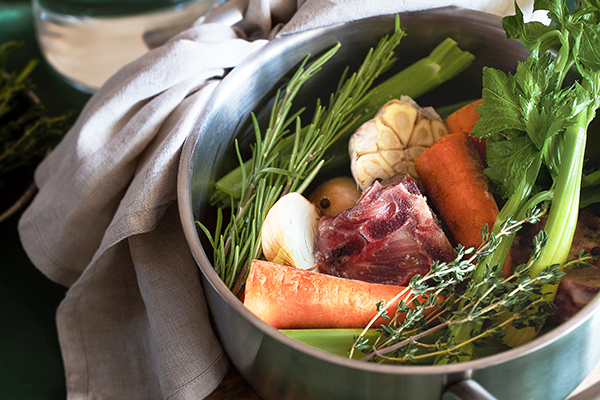Is Bone Broth REALLY All That? Here’s the 411

Bone broth has been bubbling to the top of the trendy food list because of its compelling health claims.
This popular brew has plenty of fans, including Paleo diehards, nutritionists, celebrities, and some sports stars.
But do bone broth benefits live up to the hype?
Bone broth is a liquid made by simmering bones with water, vegetables, and seasoning for hours, perhaps even days.
Proponents claim that the long cooking process unleashes beneficial amino acids, vitamins, and minerals.
The broth becomes a nutritious elixir that is allegedly capable of reducing inflammation and improving joints, bones, skin, and digestion.
That sounds fantastic, but are these bone broth benefits all true? Does bone broth really work?
Sorry, not really. Let’s separate the real benefits from those that are just hype.

Bone Broth Benefits That Are Hype
As far as science is concerned, we have few bones to pick over these claims of bone broth benefits:
1. “Bone broth soothes joint pain”
Though bone broth has collagen, a connective tissue that cushions joints, there isn’t evidence that it can make joint pain go away.
“Just because joints are made from collagen, eating collagen doesn’t transfer one to one into building stronger joints in your body,” says Krista Maguire, R.D. “Collagen protein is digested like all other proteins, broken down into individual amino acids and then used to build new proteins.”
2. “Bone broth makes bones strong”
Surprisingly there’s very little calcium in your bone broth, even though it’s made from bones.
3. “Bone broth firms up the skin”
Collagen helps skin stay plump and youthful, but that doesn’t mean that eating more collagen will improve your skin.
Just because you eat collagen doesn’t guarantee that it’ll be broken down, absorbed, and sent to your skin.
4. “Bone broth improves digestion”
There is no evidence that bone broth can improve digestive issues, even though it might feel really comforting to snuggle up with a hot mug of broth when you feel ill.

Bone Broth Nutrition
Comprehensive nutrition info isn’t available for bone broth, so we used the next best thing: homemade chicken broth.
You can review the chart to see how bone broth stacks up against regular broth.
Keep in mind there are minor nutrient differences if you look at beef bone broth or fishbone broth instead.
Here are the main points from the chart:
- Bone broth is higher in calories, protein, vitamin A and almost all the minerals we looked into, except calcium. Says Maguire, “Bone broth contains about a good amount of protein, up to 10 grams per cup, depending on the brand or how it’s made.”
- Even though it contains more minerals than regular broth, a cup of bone broth provides very little minerals compared to how much you need per day (as measured by dietary reference intake).
- You’d need to drink a lot of bone broth to get meaningful amounts for some of these minerals. At 86 calories a cup, that may not be a realistic thing to do.
Takeaway: Bone broth is more nutritious than regular broth and can definitely be enjoyed as part of a healthy diet.
| Homemade Chicken Broth (1 cup) | Chicken Broth (1 cup) | Dietary Reference Intake (DRI) Ages 19-30 | |
| Calories | 86 | 14 | — |
| Fat (g) | 2.9 | 0.5 | — |
| Carbohydrates (g) | 8.5 | 1 | — |
| Protein (g) | 6 | 1.5 | — |
| Calcium (mg) | 7.2 | 9.6 | 1,000* |
| Magnesium (mg) | 9.6 | 2.4 | Male: 400 Female: 310* |
| Potassium (mg) | 252 | 43.2 | Male: 3,400 Female: 3,400* |
| Phosphorus (mg) | 64.8 | 9.6 | 700* |
| Zinc (mg) | 0.3 | 0.2 | Male: 11 Female: 8* |
| Iron (mg) | 0.5 | 0.2 | Male: 11 Female: 8* |
| Vitamin A (mcg) | 2.4 | 0 | Male: 900 Female: 700** |
*These are the daily dietary reference intake (DRI) for minerals. For other age ranges of DRI’s please refer to these charts.
**This is the daily dietary reference intake (DRI) for vitamins. For other age ranges of DRI’s please refer to these charts.

The Health Benefits of Bone Broth
Bone broth can’t always cure what ails you, but it does come with other perks.
Here are some bone broth benefits that you can enjoy.
1. Bone broth levels up your soup game
It’s no secret that a homemade bone broth will beat canned broth in terms of taste.
2. Bone broth is waste-savvy
By using every part of the meat you buy — even the bones — you save on money and food waste.
3. Bone broth is easy to make
Despite the long cooking time, bone broth is low-effort because you can let the pot simmer unwatched for hours.
To start your own batch, try this easy Beef Bone Broth recipe with just 20 minutes of prep time!
4. Bone broth can help with rehydration
It contains electrolytes — sodium, calcium, potassium — to help you absorb fluid more quickly. Try sipping on some bone broth after your next sweat sesh!
5. Bone broth might help with nasal congestion
According to Maguire, “If you use bone broth recipes like chicken soup, there is some evidence that it can benefit someone with a stuffy nose.”
What Are the Side Effects of Bone Broth?
Bone broth is a safe food, especially if enjoyed in reasonable amounts. So, how often should you drink bone broth?
As much as you’d like. After you get past all the hype, there’s no need to aim for a specific frequency.
Maguire adds, “To my knowledge, consuming bone broth is safe and, when combined with loads of veggies, can be a vessel to a healthful meal. However, as with everything, remember moderation. One study pointed out that too much could contribute to lead intake.”
But until there’s an uptick in lead poisoning from bone broth, we’re going to say the side effects of bone broth are nil.
